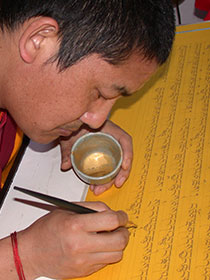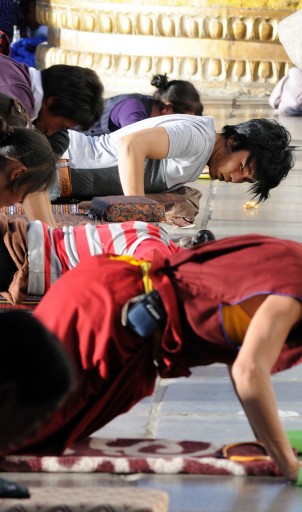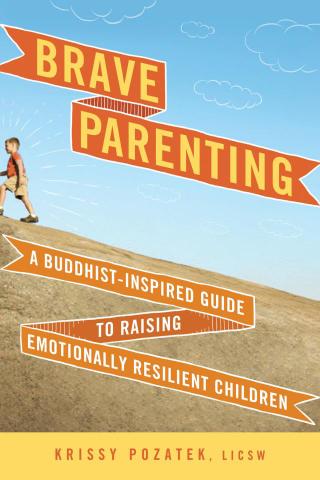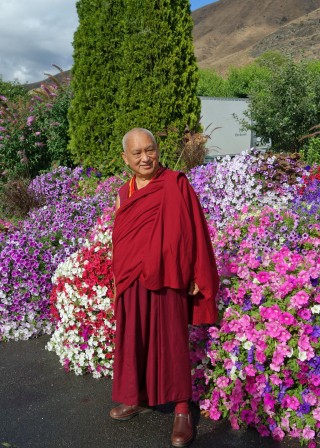- Home
- FPMT Homepage
Foundation for the Preservation of the Mahayana Tradition
The FPMT is an organization devoted to preserving and spreading Mahayana Buddhism worldwide by creating opportunities to listen, reflect, meditate, practice and actualize the unmistaken teachings of the Buddha and based on that experience spreading the Dharma to sentient beings. We provide integrated education through which people’s minds and hearts can be transformed into their highest potential for the benefit of others, inspired by an attitude of universal responsibility and service. We are committed to creating harmonious environments and helping all beings develop their full potential of infinite wisdom and compassion. Our organization is based on the Buddhist tradition of Lama Tsongkhapa of Tibet as taught to us by our founders Lama Thubten Yeshe and Lama Thubten Zopa Rinpoche.
- Willkommen
Die Stiftung zur Erhaltung der Mahayana Tradition (FPMT) ist eine Organisation, die sich weltweit für die Erhaltung und Verbreitung des Mahayana-Buddhismus einsetzt, indem sie Möglichkeiten schafft, den makellosen Lehren des Buddha zuzuhören, über sie zur reflektieren und zu meditieren und auf der Grundlage dieser Erfahrung das Dharma unter den Lebewesen zu verbreiten.
Wir bieten integrierte Schulungswege an, durch denen der Geist und das Herz der Menschen in ihr höchstes Potential verwandelt werden zum Wohl der anderen – inspiriert durch eine Haltung der universellen Verantwortung und dem Wunsch zu dienen. Wir haben uns verpflichtet, harmonische Umgebungen zu schaffen und allen Wesen zu helfen, ihr volles Potenzial unendlicher Weisheit und grenzenlosen Mitgefühls zu verwirklichen.
Unsere Organisation basiert auf der buddhistischen Tradition von Lama Tsongkhapa von Tibet, so wie sie uns von unseren Gründern Lama Thubten Yeshe und Lama Thubten Zopa Rinpoche gelehrt wird.
- Bienvenidos
La Fundación para la preservación de la tradición Mahayana (FPMT) es una organización que se dedica a preservar y difundir el budismo Mahayana en todo el mundo, creando oportunidades para escuchar, reflexionar, meditar, practicar y actualizar las enseñanzas inconfundibles de Buda y en base a esa experiencia difundir el Dharma a los seres.
Proporcionamos una educación integrada a través de la cual las mentes y los corazones de las personas se pueden transformar en su mayor potencial para el beneficio de los demás, inspirados por una actitud de responsabilidad y servicio universales. Estamos comprometidos a crear ambientes armoniosos y ayudar a todos los seres a desarrollar todo su potencial de infinita sabiduría y compasión.
Nuestra organización se basa en la tradición budista de Lama Tsongkhapa del Tíbet como nos lo enseñaron nuestros fundadores Lama Thubten Yeshe y Lama Zopa Rinpoche.
A continuación puede ver una lista de los centros y sus páginas web en su lengua preferida.
- Bienvenue
L’organisation de la FPMT a pour vocation la préservation et la diffusion du bouddhisme du mahayana dans le monde entier. Elle offre l’opportunité d’écouter, de réfléchir, de méditer, de pratiquer et de réaliser les enseignements excellents du Bouddha, pour ensuite transmettre le Dharma à tous les êtres. Nous proposons une formation intégrée grâce à laquelle le cœur et l’esprit de chacun peuvent accomplir leur potentiel le plus élevé pour le bien d’autrui, inspirés par le sens du service et une responsabilité universelle. Nous nous engageons à créer un environnement harmonieux et à aider tous les êtres à épanouir leur potentiel illimité de compassion et de sagesse. Notre organisation s’appuie sur la tradition guéloukpa de Lama Tsongkhapa du Tibet, telle qu’elle a été enseignée par nos fondateurs Lama Thoubtèn Yéshé et Lama Zopa Rinpoché.
Visitez le site de notre Editions Mahayana pour les traductions, conseils et nouvelles du Bureau international en français.
Voici une liste de centres et de leurs sites dans votre langue préférée
- Benvenuto
L’FPMT è un organizzazione il cui scopo è preservare e diffondere il Buddhismo Mahayana nel mondo, creando occasioni di ascolto, riflessione, meditazione e pratica dei perfetti insegnamenti del Buddha, al fine di attualizzare e diffondere il Dharma fra tutti gli esseri senzienti.
Offriamo un’educazione integrata, che può trasformare la mente e i cuori delle persone nel loro massimo potenziale, per il beneficio di tutti gli esseri, ispirati da un’attitudine di responsabilità universale e di servizio.
Il nostro obiettivo è quello di creare contesti armoniosi e aiutare tutti gli esseri a sviluppare in modo completo le proprie potenzialità di infinita saggezza e compassione.
La nostra organizzazione si basa sulla tradizione buddhista di Lama Tsongkhapa del Tibet, così come ci è stata insegnata dai nostri fondatori Lama Thubten Yeshe e Lama Zopa Rinpoche.
Di seguito potete trovare un elenco dei centri e dei loro siti nella lingua da voi prescelta.
- 欢迎 / 歡迎
简体中文
“护持大乘法脉基金会”( 英文简称:FPMT。全名:Foundation for the Preservation of the Mahayana Tradition) 是一个致力于护持和弘扬大乘佛法的国际佛教组织。我们提供听闻,思维,禅修,修行和实证佛陀无误教法的机会,以便让一切众生都能够享受佛法的指引和滋润。
我们全力创造和谐融洽的环境, 为人们提供解行并重的完整佛法教育,以便启发内在的环宇悲心及责任心,并开发内心所蕴藏的巨大潜能 — 无限的智慧与悲心 — 以便利益和服务一切有情。
FPMT的创办人是图腾耶喜喇嘛和喇嘛梭巴仁波切。我们所修习的是由两位上师所教导的,西藏喀巴大师的佛法传承。
繁體中文
護持大乘法脈基金會”( 英文簡稱:FPMT。全名:Found
ation for the Preservation of the Mahayana Tradition ) 是一個致力於護持和弘揚大乘佛法的國際佛教組織。我們提供聽聞, 思維,禪修,修行和實證佛陀無誤教法的機會,以便讓一切眾生都能 夠享受佛法的指引和滋潤。 我們全力創造和諧融洽的環境,
為人們提供解行並重的完整佛法教育,以便啟發內在的環宇悲心及責 任心,並開發內心所蘊藏的巨大潛能 — 無限的智慧與悲心 – – 以便利益和服務一切有情。 FPMT的創辦人是圖騰耶喜喇嘛和喇嘛梭巴仁波切。
我們所修習的是由兩位上師所教導的,西藏喀巴大師的佛法傳承。 察看道场信息:
- FPMT Homepage
- News/Media
-
- Study & Practice
-
-
- About FPMT Education Services
- Latest News
- Programs
- New to Buddhism?
- Buddhist Mind Science: Activating Your Potential
- Heart Advice for Death and Dying
- Discovering Buddhism
- Living in the Path
- Exploring Buddhism
- FPMT Basic Program
- FPMT Masters Program
- FPMT In-Depth Meditation Training
- Maitripa College
- Lotsawa Rinchen Zangpo Translator Program
- Universal Education for Compassion & Wisdom
- Online Learning Center
-
- Prayers & Practice Materials
- Overview of Prayers & Practices
- Full Catalogue of Prayers & Practice Materials
- Explore Popular Topics
- Benefiting Animals
- Chenrezig Resources
- Death & Dying Resources
- Lama Chopa (Guru Puja)
- Lama Zopa Rinpoche: Compendium of Precious Instructions
- Lama Zopa Rinpoche: Life Practice Advice
- Lama Zopa Rinpoche Practice Series
- Lamrim Resources
- Mantras
- Prayer Book Updates
- Purification Practices
- Sutras
- Thought Transformation (Lojong)
- Audio Materials
- Dharma Dates - Tibetan Calendar
- Translation Services
- Publishing Services
- Ways to Offer Support
- Prayers & Practice Materials
-
- Teachings and Advice
- Find Teachings and Advice
- Lama Zopa Rinpoche Advice Page
- Lama Zopa Rinpoche: Compendium of Precious Instructions
- Lama Zopa Rinpoche Video Teachings
- ༧སྐྱབས་རྗེ་བཟོད་པ་རིན་པོ་ཆེ་མཆོག་ནས་སྩལ་བའི་བཀའ་སློབ་བརྙན་འཕྲིན།
- Podcasts
- Lama Yeshe Wisdom Archive
- Buddhism FAQ
- Dharma for Young People
- Resources on Holy Objects
- Teachings and Advice
-
-
*If a menu item has a submenu clicking once will expand the menu clicking twice will open the page.
-
-
- Centers
-
- Teachers
-
- Projects
-
-
-
-
*If a menu item has a submenu clicking once will expand the menu clicking twice will open the page.
-
-
- FPMT
-
-
-
-
-
The essence of the guru is wisdom: the perfectly clear and radiant state of mind in which bliss and the realization of emptiness are inseparably unified.
Lama Thubten Yeshe
-
-
-
- Shop
-
-
-
The Foundation Store is FPMT’s online shop and features a vast selection of Buddhist study and practice materials written or recommended by our lineage gurus. These items include homestudy programs, prayers and practices in PDF or eBook format, materials for children, and other resources to support practitioners.
Items displayed in the shop are made available for Dharma practice and educational purposes, and never for the purpose of profiting from their sale. Please read FPMT Foundation Store Policy Regarding Dharma Items for more information.
-
-
Mandala
6
Challenging Orthodoxy in Tibetan Buddhism
In the July-September 2014 issue of Mandala, Master Program graduate and FPMT-registered teacher Patrick Lambelet answers the questions: How do I challenge orthodoxy in Tibetan Buddhism but still correctly rely on a spiritual guide? How do the ways in which Tibetans and non-Tibetans challenge orthodoxy differ?
He begins his answer: ”As an aspiring practitioner and teacher of Buddhism, I often struggle with the question of how to balance respect for tradition, which allows us to cultivate faith in Dharma, while not giving up a healthy level of skepticism and critical inquiry. The process of investigation is an indispensable part of our progression towards a more awakened, more compassionate, and wiser state – the goal of Buddhist practice – and many Western Buddhists come from a perspective that is highly suspicious of orthodoxy or dogma. His Holiness the Dalai Lama often refers to the foundation of Tibetan Buddhism as the ‘Nalanda Tradition,’ which emphasizes studying the Buddhist teachings based not just on faith, but also on rigorous investigation. This emphasis is illustrated by the analogy of a merchant who buys gold only after determining its purity through various tests; in the same way, we need to investigate the Dharma deeply before accepting it, not just taking it at the word of the person who presents it, no matter how impressive or eloquent they may be. Buddhism appeals to this rationality by challenging ingrained ideas about suffering, happiness, and the nature of reality, but when we study with traditionally trained Tibetan teachers, we often find that the teachings are intertwined with cultural assumptions that do not fit neatly with a strictly rational perspective. It turns out that applying rigorous inquiry to traditional Buddhist teachings is more delicate than it appears. A case in point is when we meet the traditional teachings on guru devotion, or reliance on a spiritual guide, as presented in the Tibetan tradition.” …
From Mandala July-September 2104
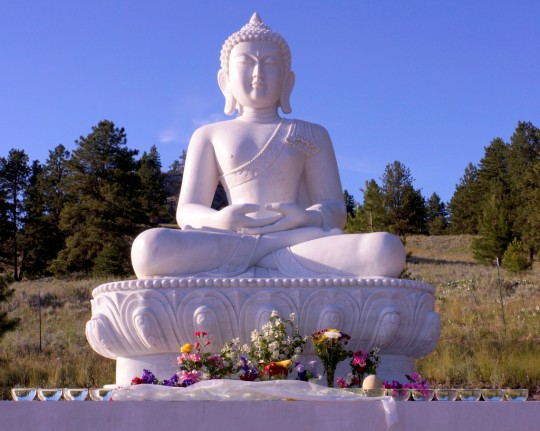
New Amitabha Buddha statue Buddha Amitabha Pure Land, Washington, US, July 2014. Photo by Merry Colony.
In early July, the residents of Buddha Amitabha Pure Land, the FPMT retreat land in Washington State in the United States, students of the near by Pamtingpa Center welcomed a large Amitabha statue to the retreat land property welcomed a large Amitabha statue to their property with a procession of incense and music. Students from near-by Pamtingpa Center also participated in the festivities. Lama Zopa Rinpoche advised the students to do many specific prayers both when the statue was installed and after the statue was filled with mantras for consecration, including Lama Tsongkhapa’s “Praise to Amitabha.”
The 13-foot (4-meter) tall statue is made of highest-quality white marble from Vietnam and weighs 16 tons (14,790 kilograms). It took over two years for the sculpting to be completed.
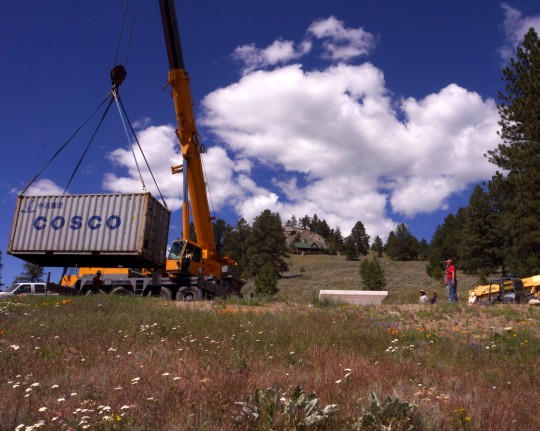
The Amitabha Buddha statue arrived in a shipping container and had to be unloaded with a crane, Buddha Amitabha Pure Land, Washington, US, June 30, 2014. Photo by Merry Colony.
Long-time student Ven. Yarpel (John Jackson) constructed a throne for the new Amitabha, which was filled with tsa-tsas and other precious items, such as ceremonial wealth vases. He also prepared the grounds for the statue’s throne and made room for the crane that lifted the statue out of its crate. Traditional Tibetan artist Gelek Sherpa has been invited to paint Amitabha and his throne.
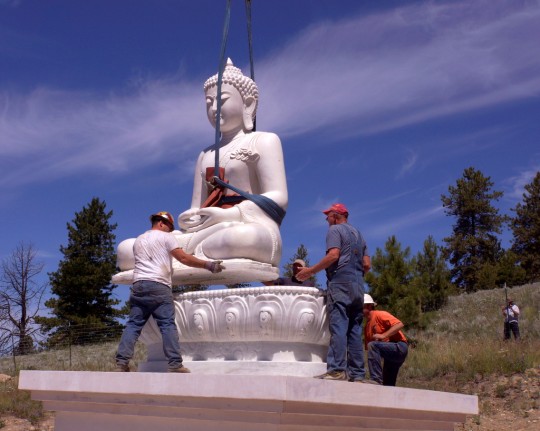
The crane was also necessary for placing the white marble statue on its throne, Buddha Amitabha Pure Land, Washington, US, June 30, 2014. Photo by Merry Colony.
When Rinpoche arrived at the land later in July, he spent time buying incredible flower offerings, describing how he wants the grounds around Amitabha to be like a “pure land” filled with trees and flowers. Already, in the gardens of Buddha Amitabha Pure Land, there are recordings playing the Sanghata Sutra and the Sutra of Golden Light 24 hours a day, blessing any beings that hear them.
Mandala brings you news of Lama Zopa Rinpoche and of activities, teachings and events from over 160 FPMT centers, projects and services around the globe. If you like what you read on Mandala, consider becoming a Friend of FPMT, which supports our work.
- Tagged: buddha amitabha pure land, mandala, pamtingpa center
- 0
31
Holding Up a Mirror to Our Children’s Behavior
A hallmark of leather laying [inappropriately shielding children from potentially stressful or upsetting situations] is when parents’ efforts are aimed at “getting through the day,” rather than giving children the necessary limits and boundaries to struggle with, to build skills for the future. Because I largely work with parents of teens, many of these children are now eighteen, and yet they are still emotionally much younger than their ages, because their parents worked so hard to get them through the semester, school year, winter break, summer, and so on. Parents are doing all the “efforting,” which removes responsibility and the maturation process from kids.
Why are parents doing so much efforting? One of the reservations we have concerning setting and enforcing limits for our children is that we may upset them. Many parents think that a large part of their job is to comfort feelings and cheer their kids up, so parents wrestle with thoughts like “How do I give a consequence for my child’s poor behavior when he may cry and feel angry – aren’t I also supposed to soothe him?” Many parents flip-flop back and forth between setting limits and then removing them and comforting their child. This ambiguity actually disrupts the moccasin-building [internal resource-building] process, because kids are rescued from their feelings and from facing consequences. Consequences, however – whether natural or logical – provide a mirror, which is a parent’s best friend. …
(Support FPMT by picking up a copy through the FPMT Foundation Store!)
From Mandala July-September 2014
31
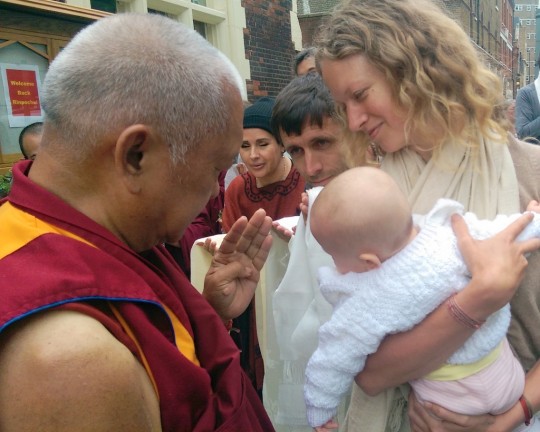
Lama Zopa Rinpoche blessing a baby upon arriving at Jamyang Buddhist Centre, London, UK, July 2014. Photo by Ven. Roger Kunsang.
Lama Zopa: practicing Dharma is giving yourself happiness!
– From Ven. Roger Kunsang’s Twitter page, posted on July 11, 2014
Ven. Roger Kunsang, Lama Zopa Rinpoche’s assistant and CEO of FPMT Inc., shares Lama Zopa Rinpoche’s recent pith sayings on Ven. Roger’s Twitter page. (You can also read them on Ven. Roger’s Facebook page.)
More information, photos and updates about FPMT spiritual director Lama Zopa Rinpoche can be found on Rinpoche’s homepage. If you’d like to receive news of Lama Zopa Rinpoche via email, sign up to Lama Zopa Rinpoche News.
- Tagged: lama zopa rinpoche, twitter
- 0
30
While staying near Madison, Wisconsin, US, Lama Zopa Rinpoche offered advice for the wildfires that were burning in Washington State, close to a number of students’ homes. Ven. Roger Kunsang, Rinpoche’s assistant and CEO of FPMT International Office in Portland, Oregon, scribed this advice for students eager to help:
1. Lama Zopa Rinpoche said that it is best to visualize the Lama Chöpa merit field and a great stream of nectar coming from the merit field and putting out the fires and especially helping the insects and animals who are suffering and perishing in the fire. This is best done in the context of doing the whole Lama Chöpa, if you have time.
Showers of nectar pour down purifying the negative karma of the suffering sentient beings, those who are suffering from the fire, and in general, the six realms sentient beings who are suffering, as well as those who have been harmed or destroyed in the fire. Also, the nectar is pouring down and changing the karma and the minds of the nagas, dergye (harmful spirits) and landlord beings, changing their negative minds, in order to not harm anymore.
It’s very important that one has one-pointed refuge in the merit field while doing this practice and one recites the mig-me mantras while doing this visualization.
2. Doing protector prayers is very good, especially tea offering to dergye as they control the elements, so it is important to appease them. But you can’t just offer tea and do nothing with the mind; you have to generate great bliss and emptiness.
3. If possible, do the extensive Medicine Buddha practice by the Great Fifth Dalai Lama.
When doing these practices, it is important to do them with good concentration and the motivation of bodhichitta.
Colophon: Scribed by Ven. Roger Kunsang, Madison, Wisconsin, US, July 2014. Lightly edited by Mandala.
More information, photos and updates about FPMT spiritual director Lama Zopa Rinpoche can be found on Rinpoche’s homepage. If you’d like to receive news of Lama Zopa Rinpoche via email, sign up to Lama Zopa Rinpoche News.
- Tagged: advice, fire, lama zopa rinpoche
- 0
29
Tara Redwood School: Sprouting the Seeds of Compassion
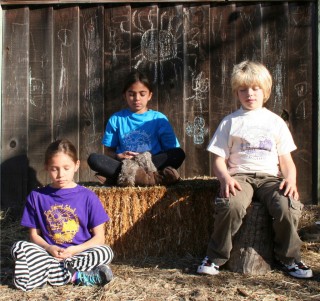
Children practicing mindfulness, Tara Redwood School, Soquel, California, US. Photo courtesy of Tara Redwood School.
Curriculum developer Amanda Bauscher at Creating Compassionate Cultures shares some of the news from Tara Redwood School and the Online Institute for Creating Compassionate Cultures in the July-September 2014 issue of Mandala:
“In the heart of Soquel Village, California, located on the Pacific Coast south of San Francisco, the old post office stands transformed as the new Elementary Campus of Tara Redwood School (TRS). Tucked away in the forest up the road, the Redwood Campus remains a refuge for Tara’s toddlers and preschoolers. These precious learning sanctuaries serve as epicenters for empowering children to make a positive difference in the lives of their friends, families and communities. By starting with children, who are just developing a sense of self, TRS acts as a ‘nursery’ for the seeds of compassion to spread throughout the world.
“Inspired by Lama Yeshe’s vision of ‘Universal Education,’ Tara Redwood School has been developing this vision for more than 25 years by working with children to develop a logical basis for compassion. This begins with an empowered sense of self and critical thinking skills infused with an understanding of the inextricable interconnection of our outer and inner worlds. ..”
From Mandala July-September 2014
28
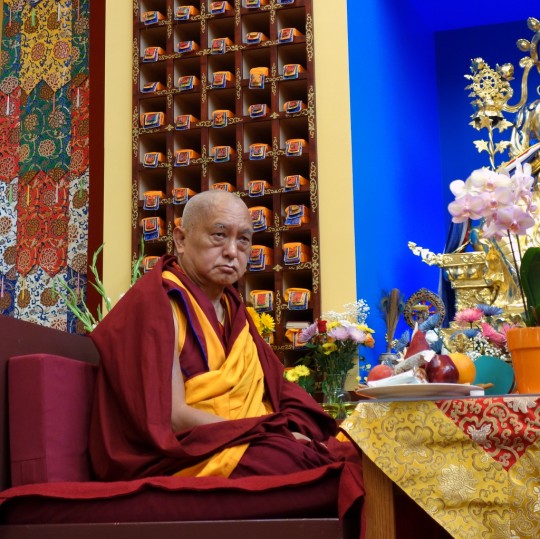
Lama Zopa Rinpoche at long life puja for Geshe Sopa Rinpoche at Deer Park Buddhist Center, Wisconsin, US, July 20, 2014. Photo by Ven. Roger Kunsang.
“[T]here’s no outside enemy. There’s a reason why people give harm to us, get angry with us or criticize us. There’s a reason, there’s a cause for that, and that cause is our mind,” Lama Zopa Rinpoche instructed. “For anybody, in any situation, even if a mosquito is biting us, the cause is our mind – attachment, anger, and of course no question about the root, ignorance. There’s no question, that’s the root. Ignorance – the concept holding things, the I and the aggregates as truly existent, which means the self-cherishing thought – that’s the real root.
“In the past we harmed others with these negative thoughts. We made mistakes, we did unrighteous actions and harmed others. What is happening now is the result of that. This mosquito biting us, that person who doesn’t like us even from the first time he saw us, that person who scolds us, even that unknown person who gets angry at us though we’ve never met before – all these things are just results, just creations of this mind. They are caused by this mind, by these negative thoughts, especially the self-cherishing thought.
“Actually, all these things are just like tools used by the people who are angry at us or who criticize us. All these things are like tools. The real enemy is our own self-cherishing thought, this ego, this ignorance, which causes anger, attachment and these delusions. The other things are like tools, like the stick that an angry person beats us with. The real reason is our own negative thought.
“It is very helpful to remember this when somebody is angry with us, scolding us or talking about our mistakes. If we can remember this at that time; that the situation is a tool, used by these negative thoughts. This is happening now because in the past we harmed that person, we did some wrong action to that person. The harm they are doing now is just a tool. The main enemy is our own negative mind.”
From Lama Zopa Rinpoche’s teaching “Don’t Get Angry at the Stick,” given at Kopan Monastery in 2008 and recently posted on the Lama Yeshe Wisdom Archive.
- Tagged: advice, lama zopa rinpoche
- 0
25
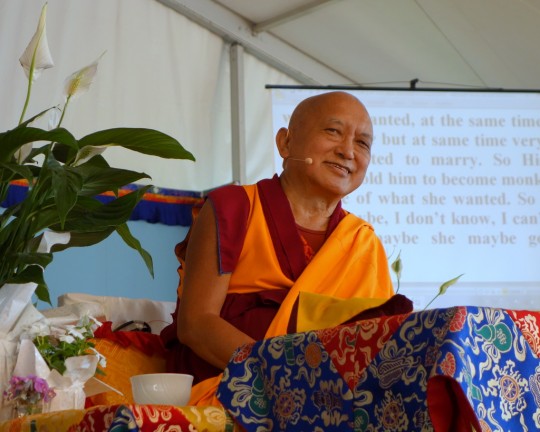
Lama Zopa Rinpoche teachings at Istituto Lama Tzong Khapa, Pomaia, Italy, June 2014. Photo by Ven. Roger Kunsang.
“After waking up in the morning, the first thing to do is to feel happy that you haven’t died yet,” Lama Zopa Rinpoche taught at Osel Shen Phen Ling, an FPMT center in Missoula, Montana, US, on August 31, 1997. This teaching, given prior to a White Tara initiation, has recently been posted on the Lama Yeshe Wisdom Archive. “‘Even last night, many people in this world died. This morning, they are no longer human beings with the opportunity to practice Dharma. So far, I haven’t died. I didn’t die last night. This is a miracle! Life is full of so many obstacles – the inner obstacles of afflictive thoughts – the 84,000 delusions that shorten our lifespan and cause death – and the external obstacles of many sicknesses and dangers. I’m so fortunate to still have this opportunity to practice Dharma.’
“The meaning and purpose of your life is to be useful and bring happiness to other beings. We have this responsibility. Why do we have this universal responsibility for the happiness of all living beings? Because if we have compassion, then we won’t harm sentient beings and they will only feel peace and happiness in our presence. It all depends on what we do with our mind. If we don’t have compassion then we are only concerned about ourselves and our own happiness, due to thoughts of self-cherishing, anger, and other negative emotions that cause us to harm other living beings, directly or indirectly, from life to life. Therefore, we have full responsibility for the happiness of all beings. (Include people in your family, people who you work with, friends, enemies, and then all sentient beings. Feel this purpose of your life and your universal responsibility first thing in the morning before doing anything else. This is very important.)
“Think to yourself, ‘I have a perfect human body; I’ve met my guru who guides me on the path to enlightenment; and I’ve met the Buddhadharma, which explains the path and methods, the causes of happiness and of suffering, what is liberation and what is samsara, what is real happiness and peace and what is illusory happiness. I’m extremely fortunate!’ Rejoice – feel very happy and appreciative. Then think, ‘Therefore, I’m going to practice sutra and tantra as much as possible on the basis of correct guru devotion.’…”
Visit the Lama Yeshe Wisdom Archive to read the entire teaching “The Meaning and Purpose of Life,” which covers reasons for taking White Tara initiation, universal responsibility and advice on making life most beneficial.
More information, photos and updates about FPMT spiritual director Lama Zopa Rinpoche can be found on Rinpoche’s homepage. If you’d like to receive news of Lama Zopa Rinpoche via email, sign up to Lama Zopa Rinpoche News.
- Tagged: advice, lama zopa rinpoche
- 0
24
What Buddha Cherishes Most: The Story of the Goats at Root Institute
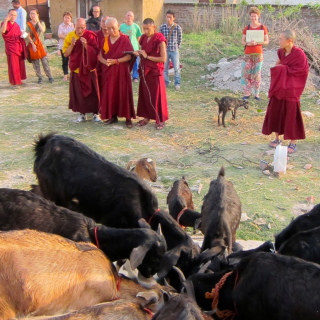
Lama Zopa Rinpoche blessing rescued goats, Bodhgaya, India, March 2014. Photo by Ven. Sarah Thresher.
Senior English nun and FPMT-registered teacher Ven. Sarah Thresher shared this story about a generous offering to the goats of Root Institute for the July-September 2014 issue of Mandala. Root Institute is a thriving FPMT center in Bodhgaya, India, the site where Buddha became enlightened:
Winter in Bodhgaya, India, can be cold. In January and February temperatures dip and nighttime is difficult without warm clothing.
This winter many goats were brought to Root Institute, the FPMT retreat center in Bodhgaya, the location of Buddha Shakyamuni’s enlightenment. They were rescued from slaughter at roadside butchers by visiting pilgrims who then brought them to the center to be looked after. (It’s very hard to pass by these butchers and watch the goats tied up awaiting death standing next to the skinned corpse of the previous goat to be killed.) However, many of the goats were already sick when they were sent to the butcher and by the time they reached the center they were traumatized and weak and often died. …
From Mandala July-September 2014
18
FPMT has more than 20 centers and study groups in four Spanish-speaking countries and Mandala features several articles translated into español, available for free online.
Student and coordinator of Thubten Kunkyab Study Group in Mexico Alejandro M. García recently translated “La Gran Estupa de la Compasión Universal” and “Progreso Gigantesco Para Los Proyectos Maitreya,” which appeared in English in the April-June 2014 issue. Spanish-speaking students can now read about the Great Stupa of Universal Compassion in Australia, slated to be the largest stupa in the Western world and the venue of the CPMT 2014 meeting in September, and about the progress of the Maitreya Projects, among the largest FPMT holy objects currently being planned and built in India.
In addition to what Mandala offers, FPMT education and practice materials, including advice from Lama Zopa Rinpoche, are available in Spanish through the FPMT Foundation Store, FPMT Hispana, and Ediciones Mahayana. You can find links to Spanish-language books by Lama Zopa Rinpoche, published by Ediciones Dharma, on the Lama Yeshe Wisdom Archive. In addition, Spanish translations of many sutras can be found on fpmt.org via the search function.
Mandala brings you news of Lama Zopa Rinpoche and of activities, teachings and events from over 160 FPMT centers, projects and services around the globe. If you like what you read on Mandala, consider becoming a Friend of FPMT, which supports our work.
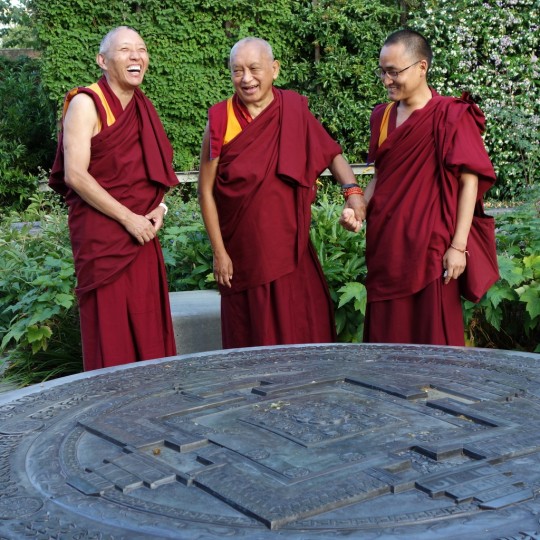
Lama Zopa Rinpoche with Jamyang Buddhist Centre resident teacher Geshe Tashi (left) and Ven. Sherab, Rinpoche’s attendant, enjoying the Kalachakra mandala in the Tibetan Peace Garden near Jamyang Buddhist Centre, London, UK, July 2014. Photo by Ven. Roger Kunsang.
Rinpoche’s public teaching in London, “Enlightened Courage,” can be watched as a streaming video recording. Rinpoche began the July 10 teaching by talking about the importance of the mind for creating happiness. He discussed how Dharma practice is the best psychology and how it can create the best healthy mind. If you don’t take care of your mind, if you use it like garbage, Rinpoche warned, then nothing pleasant results in this life and in future lives.
“The key thing is the mind,” Rinpoche said. “Happiness, you switch life to happiness or you switch mind to suffering. Like TV, which channel you want? Some war and fighting, or something very beautiful, countryside, something peaceful, people enjoying. What you do with your mind, its like that. So everything is about the mind.”
https://new.livestream.com/accounts/2729219/events/3158980/videos/56192402/player?width=560&height=315&autoPlay=false&mute=false
Rinpoche went on to teach about bodhichitta, Lama Atisha and lam-rim practice. He shared a Tibetan saying: “The turtle perseveres slowly, goes very slowly, but reaches there. Whereas the flea jumps, is jumping, but doesn’t reach far.” He explained that perserverance and continouity are very important to Dharma practice. Rinpoche also discussed karma.
The public teaching was organized by Jamyang Buddhist Centre in London. Rinpoche’s teaching in Leeds are also available as video recordings.
More information, photos and updates about FPMT spiritual director Lama Zopa Rinpoche can be found on Rinpoche’s homepage. If you’d like to receive news of Lama Zopa Rinpoche via email, sign up to Lama Zopa Rinpoche News.
- Tagged: lama zopa rinpoche, video
- 0
14
Confessions of a Mahamudra Junkie
“Buddhist in the Trenches” columnist Sarah Shifferd offers insight into her personal experience with Mahamudra, a practice of the “mind focused on mind” in the July-September 2014 issue of
Mandala.
Mahamudra is like standing in front of an aquarium. Normally, we’d watch the fish, but this time, we watch the water the fish swim in. The fish are still there, still swimming by, but the mind is on the water that holds them. With our minds, normally we are engrossed in our thoughts. In other forms of meditation, we create the thoughts and images that are supposed to be there. But this time, we just watch mind. The thoughts are still there, still arising and falling away, but mind is focused on mind.
Not only is mind focused on mind, but mind is all there is. Nothing exists but mind. All thoughts, all sensations, all objects, all sounds are merely mind. There is no “out there” to disturb the “in here,” and ultimately, the “in here” that is disturbed is revealed to be just mind. Nothing more.
The more we experience just mind, the more spacious and blissful we feel, and the harder it is for people or events to knock us out of that state. Ultimately, the mind becomes strong, unmovable even by catastrophic events. …
From Mandala July-September 2014
- Home
- News/Media
- Study & Practice
- About FPMT Education Services
- Latest News
- Programs
- New to Buddhism?
- Buddhist Mind Science: Activating Your Potential
- Heart Advice for Death and Dying
- Discovering Buddhism
- Living in the Path
- Exploring Buddhism
- FPMT Basic Program
- FPMT Masters Program
- FPMT In-Depth Meditation Training
- Maitripa College
- Lotsawa Rinchen Zangpo Translator Program
- Universal Education for Compassion & Wisdom
- Online Learning Center
- Prayers & Practice Materials
- Overview of Prayers & Practices
- Full Catalogue of Prayers & Practice Materials
- Explore Popular Topics
- Benefiting Animals
- Chenrezig Resources
- Death & Dying Resources
- Lama Chopa (Guru Puja)
- Lama Zopa Rinpoche: Compendium of Precious Instructions
- Lama Zopa Rinpoche: Life Practice Advice
- Lama Zopa Rinpoche Practice Series
- Lamrim Resources
- Mantras
- Prayer Book Updates
- Purification Practices
- Sutras
- Thought Transformation (Lojong)
- Audio Materials
- Dharma Dates – Tibetan Calendar
- Translation Services
- Publishing Services
- Teachings and Advice
- Find Teachings and Advice
- Lama Zopa Rinpoche Advice Page
- Lama Zopa Rinpoche: Compendium of Precious Instructions
- Lama Zopa Rinpoche Video Teachings
- ༧སྐྱབས་རྗེ་བཟོད་པ་རིན་པོ་ཆེ་མཆོག་ནས་སྩལ་བའི་བཀའ་སློབ་བརྙན་འཕྲིན།
- Podcasts
- Lama Yeshe Wisdom Archive
- Buddhism FAQ
- Dharma for Young People
- Resources on Holy Objects
- Ways to Offer Support
- Centers
- Affiliates Area
- Teachers
- Projects
- Charitable Projects
- Make a Donation
- Applying for Grants
- News about Projects
- Other Projects within FPMT
- Support International Office
- Projects Photo Galleries
- Give Where Most Needed
- FPMT
- Shop
Subscribe to FPMT News
Translate*
*powered by Google TranslateTranslation of pages on fpmt.org is performed by Google Translate, a third party service which FPMT has no control over. The service provides automated computer translations that are only an approximation of the websites' original content. The translations should not be considered exact and only used as a rough guide.It is necessary to help others, not only in our prayers, but in our daily lives. If we find we cannot help others, the least we can do is to not harm them.







